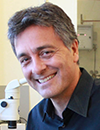Tuesday, 13 September 202208:00 | Conference Registration, Materials Pick-Up, Morning Coffee and Tea | |
Session Title: Conference Opening Session -- Organoids and Tissue Chips Status 2022 |
| | 09:00 |  | Conference Chair Tumor-on-a-Chip Platforms for High-Fidelity Cancer Drug Testing Using Intact Tumor Biopsies
Albert Folch, Professor of Bioengineering, University of Washington, United States of America
Cancer remains a major healthcare challenge worldwide. It is now well established that cancer cells constantly interact with fibroblast cells, endothelial cells, immune cells, signaling molecules, and the extracellular matrix in the tumor microenvironment (TME). Present tools to study drug responses and the TME have not kept up with drug testing needs. Oncology drugs typically take 10 years and cost an average of 1 billion dollars to develop. The number of clinical trials of combination therapies has been climbing at an unsustainable rate, with 3,362 trials launched since 2006 to test PD-1/PD-L1-targeted monoclonal antibodies alone or in combination with other agents. We have developed a microfluidic platform (called Oncoslice) for the delivery of multiple drugs with spatiotemporal control to live tumor biopsies, which retain the TME. We have developed the use of Oncoslice for the delivery of small-molecule cancer drug panels to glioblastoma (GBM) xenograft slices as well as to slices from patient tumors (GBM and colorectal liver metastasis). In addition, we have developed a precision slicing methodology that allows for producing large numbers of cuboidal micro-tissues (“cuboids”) from a single tumor biopsy. We have been able to trap cuboids in arrays of microfluidic traps in a multi-well platform. This work allows for multiplexing the application of drugs to human tumor tissues in a format that maintains the TME intact. |
| 09:30 |  | Keynote Presentation Human Type 1 Diabetes On-a-Chip
Matthias von Herrath, Vice President and Senior Medical Officer, Novo Nordisk, Professor, La Jolla Institute, United States of America
Over the past years we have engineered an in vitro system that can replicate key aspects we have seen in human type 1 diabetes pathogenesis. We will demonstrate the system's utility, notably that the readout is very sensitive in respect to beta cell function (glucose induced insulin secretion), rather than cell death. In addition the readout, due to the uniform islet spheroid size, is highly standardized. This system can be helpful in understanding which factors and pathways are key for beta cell destruction and their relative importance. It is also useful in evaluating the ability of beta cell targeted therapies to lower the immune attack. |
| 10:00 | Constructing Organ-Specific Microvasculature for Disease Modeling and Regeneration
Ying Zheng, Associate Professor, Department of Bioengineering, University of Washington, United States of America
Engineered tissues have emerged as promising new approaches to repair damaged tissues as well as to provide useful platforms for drug testing and disease modeling. Challenges remain to reconstruct organ-specific vasculature and tissue environment for disease modeling. Here I will present our progress in generating complex vascular structure with large range of diameters and curvatures, by combining multiple fabrication tools, to support its remodeling, thick tissue growth and blood perfusion. I will present means to study organ-specific vascular structure and function. Finally I will summarize the remaining challenges and perspective in exploiting engineering tools to advance our understanding of biology and medicine. | 10:30 |  | Keynote Presentation Using Microchannels to Study Endothelium in vitro
Elisabeth Verpoorte, Chair of Analytical Chemistry and Pharmaceutical Analysis, University of Groningen, Netherlands
Microfluidic systems incorporating endothelial cell monolayers were among the earliest examples of organs-on-chips, with examples dating back almost two decades. This was to be expected, as microchannels are an obvious (though perhaps not perfect) mimic for the (micro)vascular system in terms of geometry. Moreover, microchannel-based in vitro systems also allow controlled application of shear stress, a crucial parameter in vivo that dictates endothelium properties. Despite this, microfluidic devices for determining shear-stress-dependent parameters like cellular morphology and endothelium permeability have been less common. In this presentation, I will present work done in our labs focusing on endothelial cell cultures in microfluidic channels and what these systems can teach us about vascular endothelium. We have worked primarily with human umbilical vein endothelial cell (HUVEC) culture in gelatin-coated glass or PDMS channels, and more recently with cells cultured on a gelatin substrate. HUVEC exhibit a clear morphological response to the surface material on which they are cultured, a response which can also be reflected in their gene expression. Moreover, cell alignment can be guided to some extent by culture in small channels and on defined gelatin features. More recently, we have considered microflow systems to study the permeability of endothelial cell monolayers in diabetes-associated microenvironments, by tracking the transport of fluorescently labelled albumin across these barriers into a gelatin layer underneath. Summarizing, in our experience even simple microchannel devices can provide insight into endothelium behaviour, under a variety of (patho)physiological conditions. |
| 11:00 | Mid-Morning Coffee, Tea and Networking in the Exhibit Hall | 11:30 | Microengineering of Organotypic Tissue On-Chip Technologies for Disease Modeling Applications
Mehdi Nikkhah, Associate Professor of Bioengineering, Arizona State University, United States of America
Development of ex vivo three-dimensional (3D) biomimetic tissue models has gained significant attention for variety of applications in biomedical and clinical research. Tissue on-chip technologies have enabled addressing the limitations of animal models to better understand the biological mechanisms of complex diseases in humans, such as cancer. These technologies have also immensely facilitated the process of drug development and discovery through creating scalable and high-throughput miniaturized platforms, to test the efficacy of multiple compounds in an efficient manner. In this seminar, Dr. Nikkhah will present the multidisciplinary research focus of his laboratory on the integration of advanced biomaterials, microscale technologies, and biology to develop the next generation of physiologically relevant and organotypic tissue on-chip platforms for disease modeling applications. Specific emphasis in this seminar will be placed on engineering of tumor microenvironment (TME) models to study cancer progression at the earliest stages of the metastatic cascade. In addition, he will also discuss the development of 3D human stem cell-derived heart on-a-chip model to study cardiovascular diseases. | 12:00 | Spatially Organized Microfluidic Models of the Lymph Node Ex Vivo
Rebecca Pompano, Associate Professor, Carter Immunology Center, University of Virginia, United States of America
Adaptive immunity begins in the lymph node, a small yet highly structured organ that has proven difficult to model with standard in vitro approaches. The intricate spatial organization and dynamic nature of cell migration through this organ traditional interface-focused organ-on-chip models of limited use. We have developed an approach that combines intact ex vivo slices of lymph node tissue with microfluidic fluid flow control, to begin to reproduce organ-level events in this fascinating tissue. Tissue slices retain the spatial organization of the tissue and are readily adopted by biomedical research laboratories. Using single-tissue cultures as well as multi-organ microfluidic cultures, we have established models of draining lymph node interactions with tumors and with vaccinated skin or muscle. Ultimately, these tools will be useful to visualize where, when, and how cells interact during immunity and inflammation, to reveal mechanisms of the immune response and inform the development of vaccines and immunotherapies. | 12:30 | Networking Lunch in the Exhibit Hall with Exhibitors and Conference Sponsors | 14:00 |  | Keynote Presentation User-Programmable Hydrogel Biomaterials to Probe and Direct 4D Stem Cell Fate
Cole DeForest, Weyerhaeuser Endowed Professor , University of Washington, United States of America
The extracellular matrix directs stem cell function through a complex choreography of biomacromolecular interactions in a tissue-dependent manner. Far from static, this hierarchical milieu of biochemical and biophysical cues presented within the native cellular niche is both spatially complex and ever changing. As these pericellular reconfigurations are vital for tissue morphogenesis, disease regulation, and healing, in vitro culture platforms that recapitulate such dynamic environmental phenomena would be invaluable for fundamental studies in stem cell biology, as well as in the eventual engineering of functional human tissue. In this talk, I will discuss some of our group’s recent successes in reversibly modifying both the chemical and physical aspects of synthetic cell culture platforms with user-defined spatiotemporal control, regulating cell-biomaterial interactions through user-programmable Boolean logic, and engineering microvascular networks that span nearly all size scales of native human vasculature (including capillaries). Results will highlight our ability to modulate intricate cellular behavior including stem cell differentiation, protein secretion, and cell-cell interactions in 4D. |
| 14:30 |  The Next Evolution in Microfluidic 3D Printing The Next Evolution in Microfluidic 3D Printing
Hemdeep Patel, President, Co-Founder, CADworks3D
Over the last decade, 3D printing has changed the way designs are created, evaluated and iterated in all industries and in every facet of life. Since 2016, CADworks3D has been an active player in the world of microfluidics & bio-engineering by showcasing how 3D printers can radically improve the cycle of design, evaluation and iteration. The CADworks3D line of microfluidic 3D printers and 3D materials has users to test a wide range of devices from clear microfluidic encapsulated chips to master molds used for casting PDMS devices. Our newest open source ProFluidics 285D microfluidic 3D printer equipped with updated optics, a next generation projector and advanced software will allow users to reproduce features that are more true to the design. Furthermore, the tell sign of pixel burn and shadow that was characteristic of the previous generation 3D printers are now a thing of the past allowing users to create smoother, superior quality surfaces finish. The ProFluidics 285D will allow users to create high quality clear microfluidic devices and master molds for casting PDMS devices.
| 15:00 |  | Keynote Presentation Using Microfluidics For Immune Cell Trafficking and Capture
Steven C. George, Edward Teller Distinguished Professor and Chair, Department of Biomedical Engineering, University of California-Davis, United States of America
Microfluidic technology has played a leading role to advance our understanding of fundamental biological processes including cell separation and isolation, next generation sequencing, and cell trafficking. Over the past five years our lab has applied the basic principles of microfluidics to control fluid shear and flow to create simple microphysiological systems to better understand: 1) how to capture and isolate rare immune cells from the peripheral circulation, and 2) the principles which guide and control immune cell (lymphocytes, monocytes, and neutrophils) trafficking in complex tissue microenvironments. For the former, we leverage the ability to coat surfaces with antigens that are recognized by rare populations of B lymphocytes in the peripheral circulation. We then control the shear force at the surface and can capture and isolate these rare cell populations. Understanding how these rare cell populations evolve over time following viral (e.g., SARS-Cov2, influenza) infection is central to understanding immunity following infection or immunization. For the latter, we are pursuing two projects. The first involves neutrophil trafficking into the cardiac muscle during COVID19-induced “cytokine storm”, including counterstrategies that limit binding of neutrophils to the inflamed endothelium. The second involves modeling myeloid cell-directed immunosuppression in the tumor microenvironment, and how counterstrategies, such as inhibiting PD-L1 or STAT3 signaling, can enhance CAR-T cell trafficking and effector function. This talk will provide an overview of our major results from each of these projects. |
| 15:30 | Mid-Afternoon Coffee and Tea Break and Networking in the Exhibit Hall | |
Session Title: Conference Joint-Plenary Session |
| | 16:00 |  | Plenary Presentation Miniaturized Colon-on-Chip for Probiotic and Drug Screening
Nancy Allbritton, Frank and Julie Jungers Dean of the College of Engineering and Professor of Bioengineering, University of Washington in Seattle, United States of America
Organ-on-chips are miniaturized devices that arrange living cells to simulate functional subunits of tissues and organs. These microdevices provide exquisite control of tissue microenvironment for the investigation of organ-level physiology and disease. Planar models enable high throughput screening with primary human intestinal epithelial cells- both stem/proliferative cells and differentiated zones. Compound screening for stimulation or inhibition of hormone secretion by enteroendocrine cells is of high value for therapeutic development given the role that hormones and neurotransmitters such as glucagon-like peptide 1 and serotonin play in regulating human feeding behavior and metabolism. These simple models can also be adapted to produce a thick, functional mucus layer with or without an oxygen gradient to create an anaerobic luminal surface for culture of colonic flora. Such devices are high of value in evaluating the impact of probiotics- a growing therapeutic area for the treatment of human disease. These planar systems can be modified to produce “flat crypts” with a stem/proliferative zone and differentiated cell region for the study of stem cell proliferation, lineage allocation and migration. Fully 3D polarized epithelium possess an array of crypt-like structures replicating the intestinal architecture. Imposition of chemical gradients across the crypt long axis yields a polarized epithelium with a cell migration from a stem-cell niche into a differentiated cell zone. This in vitro human colon crypt array replicates the architecture, luminal accessibility, tissue polarity, mucus layer, cell types and cellular responses of in vivo intestinal crypts. These bioanalytical systems provide both high throughput as well as low throughput/content rich platforms for assay of microbiome-behavior, drug-delivery, and other assays with a living human intestinal epithelium. |
| 16:30 |  | Plenary Presentation New Fluorescent Reagents to Enable Highly Multiplexed Single-Cell Measurements and Biological Assays
Daniel Chiu, A. Bruce Montgomery Professor of Chemistry, University of Washington, United States of America
Fluorescence based techniques have become an indispensible tool kit in
both basic cellular studies and in vitro diagnostics. However, the
intrinsic limitations of conventional dyes, such as short Stoke’s shift
and low absorptivity, have posed difficulties for advancing highly
multiplexed assays. We have developed a new class of fluorescent probes
called Pdots, and this talk will highlight their development to enable
high multiplex single-cell analysis and biological assays. |
| 17:00 |  | Plenary Presentation The NIH Microphyiological Systems Program: In Vitro 3D Models for Safety and Efficacy Studies
Danilo Tagle, Director, Office of Special Initiatives, National Center for Advancing Translational Sciences at the NIH (NCATS), United States of America
Approximately 30% of drugs have failed in human clinical trials due to adverse reactions despite promising pre-clinical studies, and another 60% fail due to lack of efficacy. A number of these failures can be attributed to poor predictability of human response from animal and 2D in vitro models currently being used in drug development. To address this challenges in drug development, the NIH Tissue Chips or Microphysiological Systems program is developing alternative innovative approaches for more predictive readouts of toxicity or efficacy of candidate drugs. Tissue chips are bioengineered 3D microfluidic platforms utilizing chip technology and human-derived cells and tissues that are intended to mimic tissue cytoarchitecture and functional units of human organs and systems. In addition to drug development, these microfabricated devices are useful for modeling human diseases, and for studies in precision medicine and environment exposures. Presentation will elaborate in the development and utility of microphysiologicals sytems and in the partnerships with various stakeholders for its implementation. |
| 17:30 |  Applications for Small Particle Analysis Using High Sensitivity Flow and Imaging Flow Cytometry Applications for Small Particle Analysis Using High Sensitivity Flow and Imaging Flow Cytometry
Haley Pugsley, Manager and Senior Scientist, Luminex Corporation
Research in the fields of virology, microbiology, nanoparticles, and
extracellular vesicles (EVs) has shown tremendous growth over the past
few years. Viruses, which range in size from 17 nm to ~1.5 microns,
small bacteria, nanoparticles, and small EVs such as exosomes (less than
150 nm in diameter), are all on the subcellular scale. Quantifying and
characterizing small particles in a reproducible and reliable manner is
challenging due to their small size. In this presentation, we will
demonstrate the capabilities for small particle applications from Amnis®
CellStream® and Amnis® ImageStream®X
Mk II. The Amnis CellStream system has the advantage of high throughput
flow cytometry with higher sensitivity to small particles due to the
CCD-based, time-delay-integration image capturing system. Here, we will
present immunophenotyping data from EVs. The Amnis ImageStreamX Mk II
that combines the quantitative power of flow cytometry with microscopy
in one system has a High Gain mode to increase the sensitivity for small
particles by adjusting the CCD-camera to a higher gain setting,
increasing the signal obtained from the small particles while minimizing
the noise. In this portion of the presentation, examples of High Gain
mode using murine leukemia virus-sfGFP will be shown.
| 18:00 | Networking Reception with Beer and Wine in the Exhibit Hall: Network with Colleagues and Engage with Exhibitors and Conference Sponsors | 19:00 | An Evening with Luminex -- Visit their Labs in Seattle, View Product Demonstrations, Enjoy Food & Drinks and Engage |
Wednesday, 14 September 202208:00 | Morning Coffee and Pastries in the Exhibit Hall | 08:30 | Engineering in Precision Medicine
Ali Khademhosseini, CEO and Founding Director, Terasaki Institute for Biomedical Innovation, United States of America
Engineered materials that integrate advances in polymer chemistry, nanotechnology, and biological sciences have the potential to create powerful medical therapies. Dr. Khademhosseini is interested in developing ‘personalized’ solutions that utilize micro- and nanoscale technolgoies to enable a range of therapies for organ failure, cardiovascular disease and cancer.In enabling this vision he works closely with clinicians (including interventional radiologists, cardiologists and surgeons). For example, he has developed numerous techniques in controlling the behavior of patient-derived cells to engineer artificial tissues and cell-based therapies. His group also aims to engineer tissue regenerative therapeutics using water-containing polymer networks called hydrogels that can regulate cell behavior. Specifically, he has developed photo-crosslinkable hybrid hydrogels that combine natural biomolecules with nanoparticles to regulate the chemical, biological, mechanical and electrical properties of gels. These functional scaffolds induce the differentiation of stem cells to desired cell types and direct the formation of vascularized heart or bone tissues. Since tissue function is highly dependent on architecture, he has also used microfabrication methods, such as microfluidics, photolithography, bioprinting, and molding, to regulate the architecture of these materials. He has employed these strategies to generate miniaturized tissues. To create tissue complexity, he has also developed directed assembly techniques to compile small tissue modules into larger constructs. It is anticipated that such approaches will lead to the development of next-generation regenerative therapeutics and biomedical devices. | |
Session Title: Technologies and Approaches in the Organs-on-Chips Field |
| | 09:00 | A 3D Bioprinted Neurovascular Unit Model for Glioblastoma Brain Tumor Formation and Drug Screening
Yen-Ting Tung, Research Fellow, 3D Tissue Bioprinting Group, National Center for Advancing Translational Sciences (NCATS), United States of America
A brain-like microenvironment, NVU, was developed to study glioblastoma (GBM) tumor formation through 3D bioprinting in a 96-well plate. This model provides a platform for studying vascular angiogenesis as well as tumor migration and anti-tumor therapy with high-content imaging systems. | 09:30 | Microdissected Tissue Processing Using Open-Space and Closed Microfluidics – From First Principles Design to Drug Testing
Thomas Gervais, Professor of Engineering Physics and Biomedical Engineering, Ecole Polytechnique de Montréal, Canada
The inability to adequately predict the response of a given patient to therapeutic agents is a major, longstanding challenge in clinical oncology. In the past decade, there has been a major push to develop ex vivo platforms to directly probe the response of a patient’s tumor to a panel of drug candidates in order to optimize drug prescription and treatment response. Due to their small sizes, versatility and precise control of the culture microenvironment, microfluidics systems have emerged as a promising approach to develop such platforms. Yet, several challenges must be solved to ensure on-chip tumor viability, simplicity of use, throughput, and to deliver quality readouts for clinical decision making. In this talk, we will discuss the concept of micro-dissected tissue (MDT) as an emerging on-chip ex vivo model that is both simple to use, and compatible with current gold standard histopathology readouts. We will introduce two platforms, drawing upon classical and open-space microfluidics, for processing them and a general method to bridge the gap between MDT processing and gold-standard histopathology. Our results set the base for a complete micro-histological platform compatible with most solid tumour cancers, that provides the equivalent of tissue microarrays to assay individual response to drugs. | 10:00 |  | Keynote Presentation 3D Mesoscale Structures as Bioelectronic Interfaces to Cortical Spheroids
John Rogers, Simpson/Querrey Professor of Materials Science and Engineering, Northwestern University, United States of America
Three-dimensional (3D), sub-millimeter-scale collections of neural cells, known as cortical spheroids and organoids, are of rapidly growing importance in neuroscience research due to their ability to reproduce complex features of brain architecture, function and organization in vitro. Despite their great potential for studies of neurodevelopment, neurological disease modeling and evolution, these miniaturized, fragile 3D living biosystems cannot be examined easily using conventional methods for neuromodulation, sensing and manipulation. This talk describes an unusual 3D neurotechnology platform that can be tailored with shapes, sizes and complex geometries that match those of individual organoids/spheroids and small collections of them, sometimes referred to as assembloids. Systematic studies demonstrate various electrical, thermal, chemical and optical modes of operation that can be supported by these frameworks, including examples of their use in monitoring electrophysiological behaviors across the surfaces of healthy human stem cell derived cortical spheroids and in examining processes of neuroregeneration between lobes of transected assembloids formed from pairs of spheroids. |
| 10:30 | Mid-Morning Coffee, Tea and Networking in the Exhibit Hall | 11:00 | A Three-Dimensional Model of the Neurovascular Unit Using Human Ex Vivo Brain Tissue
Brian O'Grady, Post-Doctoral Researcher, Vanderbilt University, United States of America
We developed a lumen-perfusable, microfluidic-based model of the neurovascular unit using ex vivo human brain tissue. This model consisted of correct spatial organization of the BBB and NVU to represent a realistic biomimetic microenvironment for drug screening and efficacy. | 11:30 | Engineering Organoids, Organs, and Societies
Kelly Stevens, Associate Professor, Department of Bioengineering, University of Washington, United States of America
Although much progress has been made in building engineered human tissues and organs over the past several decades, replicating complex tissues remains an enormous challenge. To overcome this challenge, our field first needs to create better three-dimensional spatial maps, or “blueprints” of human tissues and organs. We also need to then understand how these spatial blueprints encode positional processes in tissues. Here, I will describe some of our work to develop multimodal “google maps” of human organs, as well as both biological and technology means to build these organs. Finally, I will speak to how we might together better built a more impactful profession by leveraging the power of all human intellect. | 12:00 | Quantitative Assays on Endocrine Tissue Every Few Seconds using Droplet-Based Microfluidic Analog-to-Digital Converters
Christopher Easley, C. Harry Knowles Professor, Auburn University, United States of America
The scale of microfluidic systems is well-matched to those of cellular systems, multi-cellular tissues, and even some small organisms. Ex vivo endocrine tissues—taken directly from animals such as mice—can be analyzed precisely and effectively with continuous flow microdevices. However, most micro-analytical systems to date have been limited to temporal resolutions in the 2-10 minute range. Our group has leveraged droplet-based microfluidics for rapid sampling of two ex vivo murine tissues (adipose tissue, pancreatic islets) with integrated on-chip assays to achieve sampling every few seconds, and these devices have been termed as microfluidic analog-to-digital converters (µADCs). Here, we use valve-automated droplet generators and salt-water electrode mergers to rapidly sample ex vivo endocrine tissues every few seconds, then quantitatively assay secreted metabolites within nanoliter droplets on-chip. Custom tissue-culture interfaces from 3D-printed templates allow proximal sampling into droplets with minimal dispersion. While continuous flow microfluidic sampling has been limited to temporal resolutions (Deltat) of about 2 minutes, our µADC devices have been validated with Deltat as low as 3.5 seconds. These novel tools have revealed new biological information on the dynamic functions of both adipose tissue (lipolytic oscillations) and pancreatic islets (acute incretin effects). | 12:30 | Networking Lunch, Meet Exhibitors and Engage with Colleagues | 14:00 | Towards Functional Precision Medicine: Microfluidic Platform For Combinatorial Drug Screening Using Stereolithography
Viraj Mehta, Research Fellow, Indian Institute of Technology, Hyderabad, India
3D printed resin based microfluidic fabrication has been gaining
popularity for the past 10 years. Although there are several reports
utilizing resin based techniques for micro fluidic tumor culture and
drug screening, multi-drug-based 3D printed tumor models are still
lacking. In this study, we report a novel microfluidic device for 3D
culture of breast and oral tumor spheroids. Our device is capable of
forming highly circular spheroids on flat bottom 3D printed microwells.
Besides, the device can test various combinations of three anti-cancer
drugs simultaneously. As the combination of drugs can reduce drug
concentrations and are more effective than single drug therapies, we
believe discovering potential drug combinations on patient-derived
samples will aid in mitigating the side effects of chemotherapy. The
tumor spheroids maintain excellent viability in the device for 120 h. We
observe differential drug sensitivities among tested patient samples
matching their diagnosis. In addition, we show that tumor spheroids can
be taken out from the developed device for downstream analysis such as
flow cytometry. | 14:30 | Using Organs-on-Chips for Screening Therapeutics for Pandemic Respiratory Infections
Jeffrey Borenstein, Group Leader, Synthetic Biology; Director, Biomedical Engineering Center, Draper, United States of America
One of the most powerful applications of organs-on-chips is as a platform for generating human-relevant data in screening therapeutic candidates across various disease models. Here we present recent therapeutic screening results obtained using the high throughput human primary tissue culture platform PREDICT96-ALI (Air Liquid Interface) across pandemic respiratory infections including Influenza A Virus (IAV) and the coronaviruses hCoV-NL63, hCoV-OC43 and SARS-CoV-2. These platforms, seeded with human primary tracheobronchial epithelial cells obtained from commercial sources as well as directly from bronchoscopies performed on living donors, enable rapid screening across a range of conditions including infection levels, cell source, candidate compound and therapeutic dose. In the case of SARS-CoV-2, this represents a first demonstration of successful therapeutic screening in a high containment BSL-3 environment. Results from the airway platform correlate closely with clinical data, demonstrating a compelling opportunity for an organ-on-chip model to serve a critical role in evaluating potential candidates capable of efficaciously treating severe respiratory infections. | 15:00 |  | Keynote Presentation Closing Keynote: All-in-one Microfluidic Design to Integrate Vascularized Tumor Spheroid into High-Throughput Platform
Noo Li Jeon, Professor, Seoul National University, Korea South
The development of a scalable and highly reproducible in vitro tumor microenvironment (TME) platform still sheds light on new insights into cancer metastasis mechanisms and anticancer therapeutic strategies. Here, we present an all-in-one injection molded plastic array three-dimensional culture platform (All-in-One-IMPACT) that integrates vascularized tumor spheroids for highly reproducible, high-throughput experimentation. This device allows the formation of self-assembled cell spheroids on a chip by applying the hanging drop method to the cell culture channel. Then, when the hydrogel containing endothelial cells and fibroblasts is injected, the spheroid inside the droplet can be patterned together in three dimensions along the culture channel. In just two steps above, we can build a vascularized TME within a defined area. This process does not require specialized user skill and minimizes error-inducing steps, enabling both reproducibility and high throughput of the experiment. We have successfully demonstrated the process, from spheroid formation to tumor vascularization, using patient-derived cancer cells (PDCs) as well as various cancer cell lines. Furthermore, we performed combination therapies with Taxol (paclitaxel) and Avastin (bevacizumab), which are used in standard care for metastatic cancer. The All-in-One IMPACT is a powerful tool for establishing various anticancer treatment strategies through the development of a complex TME for use in high-throughput experiments. |
|
|
